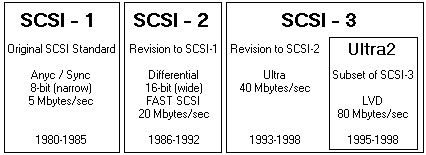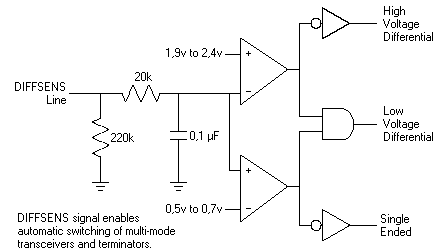Low Voltage Differential (LVD) devices are defined under the Ultra2 subset of the SCSI-3 standard. Industry wide, the terms LVD and Ultra2 SCSI are used interchangeably. LVD provides SCSI bus data rates of 80 Mbytes/sec. That's double the fastest SCSI-2 standard (40 Mbytes/sec), and light years ahead of the SCSI-1 standard used prior to 1992 in which SCSI bus rates were as slow as 3 Mbytes/sec. This increased bandwidth means optimal performance for server environments where rapid response is required and random access and large queues are the norm. When using applications such as CAD and CAM, digital video and any RAID environment, the increased bandwidth is immediately noticeable as information is moved quickly and effortlessly. LVD increases the maximum burst transfer rates to 80 Mbytes/sec, provides differential data integrity, extends the SCSI bus cable lengths to 25 meters (12 meters with 16 devices) and provides easy system configuration for up to 16 devices. This is a dramatic increase from Ultra SCSI single-ended cable restrictions of 3 meters and maximum burst transfer rates of 40 Mbytes/sec. The lower voltage requirements of LVD versus HVD allow for the integration of the differential drivers and receivers into the drive's on-board SCSI controller. The older Ultra HVD design requires separate and costly high-voltage components. As a result, LVD provides the integrity of high voltage differential designs at the system cost of single-ended I/O. LVD is fully compatible with the existing installed single-ended SCSI base. A unique DiffSens circuit determines the type of SCSI bus the device is being used on, LVD or single-ended, and configures the drive operation to the appropriate bus capability. The following diagram shows the three bus operational states and the resulting LVD compatibility. HVD devices require a special controller and are not compatible with LVD or single-ended devices; therefore, when DiffSens senses an HVD device, it disables the operation.
LVD is a subset of the SCSI-3 standard. LVD devices will work on SCSI-1and SCSI-2 bus segments. Conversely, older SCSI-1 and SCSI-2 single-ended devices will work on an LVD bus. Compatibility is an important SCSI feature, but when using SCSI devices of different vintage on the same SCSI bus, all peripherals on that bus will respond to the earliest version SCSI specification. If an Ultra device is installed on an LVD bus, all devices on the bus will respond at Ultra mode.  The 16-bit Wide SCSI connection is required to achieve the maximum LVD bus data rates of 80 Mbytes/sec. Because of this requirement, the future of the 8-bit Narrow SCSI bus is limited, and Seagate has no plans to produce 8-bit Narrow LVD devices. All Seagate designs will incorporate LVD using the standard 68-pin Wide SCSI connector or the 80-pin single connector (SCA-2) when multiple drives and easy integration are required. The low voltage and current component of LVD allows the differential transceivers to be implemented into the drive's on-board SCSI controller, eliminating the need for separate and costly external high voltage differential components. Disc drive data rates double about every three years. Drives, with data rates of 10 Mbytes/sec, work well with an Ultra SCSI bandwidth of 40 Mbytes/sec. The Barracuda and Cheetah drives have recorded sustained transfer rates as fast as 20 Mbytes/sec. Multiple drive applications require the 80 Mbytes/sec bandwidth provided by LVD. LVD also provides for easy integration of up to 16 devices on the SCSI bus using 12 meters of cable, the data integrity of differential at the same cost as the older single-ended designs and the parallel SCSI bus performance needed for Seagate’s high-performance Barracuda and Cheetah drive families. |
